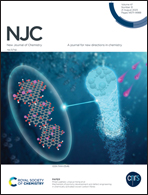Coexistence mechanisms of negative differential resistance and resistive switching effects in a WOx-based memristor†
Abstract
Metal oxide memristors are highly desirable for bionic synaptic applications. Recently, negative differential resistance (NDR) effects have been found in the resistance switching (RS) region for some oxide memristors, which provide a basis for multifunctional devices. Here, the mechanisms of the coexistence of NDR and RS behaviors in a W/WOx/Ti memristor are analyzed. The WOx-based memristor shows good synaptic plasticity behavior with a bipolar RS effect, and the NDR behavior during reverse voltage scanning is due to the dual role of conductive filaments (CFs) and trap-assisted transport (TAT) mechanisms. As the number of scans increases, fracture of the CFs is accelerated, while oxygen vacancy concentrations are reduced. The TAT mechanism is not enough to assist the electronic transition, thus leading to change in the NDR effect. In addition, replacing WOx with Al2O3 can lead to the disappearance of the NDR behavior, and the RS effect is switched from digital to analog type. This work provides a promising pathway to understand the coexistence mechanisms of NDR and RS effects in metal oxide memristors and promotes their application in bifunctional devices.



 Please wait while we load your content...
Please wait while we load your content...